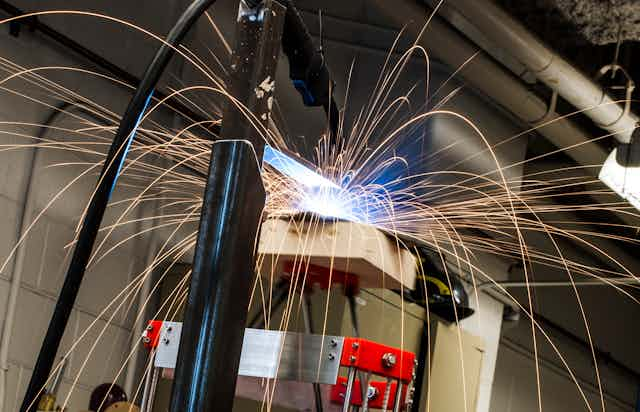A challenge for university researchers is to make the best use of any funding on their projects and anything that can save money should be welcomed.
University representatives are already asking the federal government not to make further cutbacks in funding in May’s budget so the chance of extra research money looks slim.
For nearly 30 years, 3D printing has been used by industry to reduce costs in the research and development phase of manufactured products.
The technology allows engineers to rapidly produce a physical prototype of a design to determine its viability and detect product defects. This process saves time and money when developing the final product.
3D printers were expensive in the 1980s and 1990s but prices have dropped significantly – from more than US$100,000 to just a few hundred dollars – so they are now accessible to general consumers and universities.
A strong open-source movement also allows individual consumers and researchers to build their own 3D printers, reducing costs even further. Yet despite its ability to reduce the cost of industrial processes, its ability to reduce both the cost and time associated with academic research hasn’t been realised to a similar level. But this is starting to change.
3D printing in the lab
One of the early adopters of using 3D printing to reduce research costs was Joshua M Pearce from Michigan Technology University. His research group is becoming well-known for designing open-source hardware using 3D printers and micro-controllers.
He also recently published a book on the subject, which outlines how researchers can build a open-source lab in order to save thousands of dollars on research costs.
His research group is currently developing one of the first open-source metal 3D printers. This will allow individuals and researchers to print functional metal parts on printers that will cost approximately A$2,000 to build (to put in perspective, commercial metal printers start at roughly half a million dollars).
Saving time and money
Ben Robotham was a research student at the Ultrafast and Microspectroscopy labs, at the University of Melbourne, who discovered the cost benefit of 3D printing.
He needed four customised brackets for some equipment but was told they would cost A$800 and take four to six weeks to manufacture. He was also told by his supervisor that they did not have the budget and he needed to find an alternative.
So he searched online for ways to create a customised bracket and found a video of a 3D printer, the first one he had seen or heard of. Without any 3D modelling experience, he downloaded some easy-to-use, free software called Sketchup to create his first 3D design.

He sent the plans via email to the University of Melbourne Digital Fabrication Facility, picked up the printed brackets the next day (free for staff and students) and they fit perfectly, saving him up to six weeks delay and A$3,200 (more than the cost of the 3D printer and material combined).
While 3D printing’s cost saving potential in research is high, there are some barriers in getting researchers to adopt the technology:
- make researchers aware of how the technology can save money (such as printing experiment apparatus in plastic instead of getting it machined in metal)
- educate as to when 3D printing technology is appropriate to their research objectives (should the researcher print the experimental apparatus in plastic, or does the experiment require metallic parts?)
- researchers require the skills to design and print their research products, or access to people who can.
Creating digital blacksmiths
In an attempt to address these barriers, the University of Melbourne’s ITS Research and School of Engineering departments collaborated to help 24 students from various backgrounds become “digital blacksmiths”.
They were taught how to conceptualise ideas, how to use open-source computer-aided design (CAD) software and how to 3D print structurally sound objects.

On the final day, they were given a business accelerator design challenge (Co-sponsored by the Melbourne Accelerator Program) and asked to develop and 3D print a business product or service, which was then pitched to a panel of professionals in the start-up sector.
Ideas ranged from 3D printing bicycle parts to custom jewellery, powerboards and spectacle frames designed fit to your face based on Xbox Kinect scans.
By the end of the course, these research students (now digital blacksmiths) could see the benefit of being able to create their own cheaper experimental equipment.
The feedback
Robbie Fordyce, a PhD student and researcher in the School of Culture and Communication, said the potential to reduce costs for reproduction was immense:
Research projects based around rare or unique items – such as within archaeological or paleontological research – are bound to see substantial benefits, where their research objects are literally priceless.
Luke Heemsbergen, a researcher who has written on 3D printing before, could also see the potential:
The ability to quickly mock up new spaces and installations with 3D printed objects offers great savings in time, money and effort. It allows you to see and feel how everything fits together before its too late.
Tim Lovell, a medical research officer at the Florey Neuroscience Institute, said he often needs to source customised equipment in his research:
Normally, the time and cost necessary to engage a large biomedical company, prevents this. With 3D printing, I was able to team up with a mechanical engineer and manufacture a custom piece that I am now using to better visualise and understand the mechanistic effects of the drug.
This “digital blacksmith” project was the first of its kind in the world but it has shown us the potential is there to teach other researchers to use 3D printers for their benefit – which can only be a good thing in a challenging economic climate.

